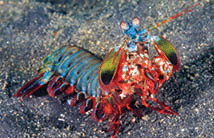Return to 1st Quarter 2021 articles.



They have the force to break an oyster shell or the glass of an aquarium with a single blow. Because of their powerful claws, people who have tried to pick them up have called them “thumb splitters.” Their real name is peacock mantis shrimp (Odontodactylus scyllarus). They are essential predators in shallow tropical and sub-tropical waters from Guam to East Africa.
Peacock mantis shrimp use their claws like hammers to smash their prey at 10,000 times the acceleration due to gravity. The supersonic motion of the shrimp's claws creates cavitation bubbles. Those tiny bubbles of water vapor collapse at supersonic speed, making shock waves that cause a second impact on the victim. This action creates not only sound waves but also small amounts of light. The cavitation force can be greater than the initial impact of the hammering by the claw, and it can damage steel boat bottoms and propellers.
The kind of force that peacock mantis shrimp can produce is not possible with muscle motion. Mantis shrimp use a saddle-shaped spring to release the energy in milliseconds. But the spring is no good without the muscular power to load the spring. But that is not enough because there also has to be a trigger to catch and then release the spring. All three of those parts must be in place to activate the powerful hammer.
The design of this system goes even further. If the shrimp released that energy with an ordinary claw, it would smash the claw to pieces. So the claw has to be designed with super strength and a flexible joint system to allow motion at supersonic speed. All of those things must be designed into the shrimp simultaneously for the system to work. This design gives evidence of a Master Engineer.
Picture credits:
© WhitcombeRD. Image from Big Stock.com
